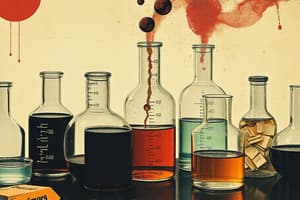Podcast
Questions and Answers
Match the chemical reactions with their respective results:
Match the chemical reactions with their respective results:
$NH4OH + HCl$ = Formation of ammonium chloride and dense white fumes $AgCl + 2NH4OH$ = Formation of curdy white precipitate soluble in excess of ammonium $Pb(NO3)2 + 2HCl$ = Formation of lead chloride, a white precipitate soluble in hot water but insoluble in cold water $MnO2 + 4HCl(conc.)$ = Formation of a greenish-yellow gas with a pungent suffocating smell
Match the substances with their reactions with hydrochloric acid:
Match the substances with their reactions with hydrochloric acid:
Ammonium hydroxide = Produces dense white fumes of ammonium chloride Silver nitrate solution = Produces curdy white precipitate soluble in excess of ammonium Lead nitrate solution = Produces a white precipitate soluble in hot water but insoluble in cold water Manganese (IV) oxide = Produces a greenish-yellow gas with a pungent suffocating smell
Match the substances with their reactions with chlorine:
Match the substances with their reactions with chlorine:
Moist blue litmus paper = Turns red and finally bleaches to white Moist starch iodide paper = Turns blue-black $HCI + HCIO + H2O$ = Decolourises chlorine $2KI + Cl2$ = Forms $2KCl + I2$
Match the chemical reactions with their products:
Match the chemical reactions with their products:
Match the industries with the use of hydrochloric acid:
Match the industries with the use of hydrochloric acid:
Match the following chemical reactions with their corresponding descriptions:
Match the following chemical reactions with their corresponding descriptions:
Match the following substances with their properties or uses:
Match the following substances with their properties or uses:
Match the following procedures with their corresponding precautions:
Match the following procedures with their corresponding precautions:
Match the following substances with their resultant products:
Match the following substances with their resultant products:
Match the following substances with the description of their reactions:
Match the following substances with the description of their reactions:
Match the following elements with their compound:
Match the following elements with their compound:
Match the following scientists with their discoveries:
Match the following scientists with their discoveries:
Match the following chemical reactions with the correct products:
Match the following chemical reactions with the correct products:
Match the following chemical reactions with the substances reacted:
Match the following chemical reactions with the substances reacted:
Match the chemical reactions with their respective observations:
Match the chemical reactions with their respective observations:
Match the reactions with their types:
Match the reactions with their types:
Match the chemical compounds with their respective colours:
Match the chemical compounds with their respective colours:
Match the following chemical reactions with the gases evolved:
Match the following chemical reactions with the gases evolved:
Match the following chemical reactions with the respective changes observed:
Match the following chemical reactions with the respective changes observed:
Match the following chemical reactions with the correct descriptions:
Match the following chemical reactions with the correct descriptions:
Match the following properties and processes with the correct descriptions:
Match the following properties and processes with the correct descriptions:
Match the following chemical reactions with the correct products:
Match the following chemical reactions with the correct products:
Match the following properties of hydrogen chloride gas with the correct descriptions:
Match the following properties of hydrogen chloride gas with the correct descriptions:
Match the following reactions of dilute hydrochloric acid with the correct descriptions:
Match the following reactions of dilute hydrochloric acid with the correct descriptions:
Match the following substances with their reactions with hydrogen chloride gas:
Match the following substances with their reactions with hydrogen chloride gas:
Match the following substances with their interactions with hydrogen chloride gas:
Match the following substances with their interactions with hydrogen chloride gas:
Flashcards are hidden until you start studying




